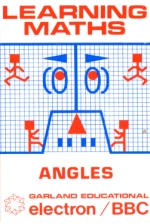Introduction
This series of programs by Chris O' Donoghue is designed for use by children in the lower years of secondary schools or in upper junior schools (9-12), or by parents and children at home. They will also have uses outside these recommended age ranges depending on the ability of the children.
Many children at this age are content to complete a mathematics problem and have it judged 'right' or 'wrong', without any regard for the principles behind it. Many so-called educational programs perpetuate this 'drill and practice' approach, and teachers have rightly criticised this use of computers. We believe that our programs illustrate in an interesting and entertaining way, many of the principles of mathematics at this level. They use animations and simple games - but not frivolous gimmicks. They have been written by a professional teacher, and thoroughly tested in schools. The programs do not attempt to replace the teacher or text-book, but they allow the computer to enrich many maths lessons. At home, they can be used by parents to help with word children are doing at school - or just for fun!
When you mention "angles" in mathematics, most children reach for a protractor! However, a protractor, and later sines, cosines, etc. are likely to be poorly used if children do not know what an angle is, and cannot estimate one in degrees with reasonable accuracy. These programs help these two areas of understanding using some routine exercises, and some games.
Please note that the computer will draw angles exactly, but if your television distorts its pictures, they may not appear as intended.
The Programs
ANGLE is not an exciting program but it is important in that it shows what an angle is: the rotation of a line about a point. It will show negative angles and angles beyond 360 degrees.
AORRT stands for Acute Obtuse Reflex RighT, and is the first stage of estimating an angle by classifying it as Acute (less than 90 degrees) Right-Angled (exactly 90 degrees) Obtuse (between 90 degrees and 180 degrees) or Reflex (greater than 180 degrees). The program is a routine one - you are given ten questions and a score out of ten.
SHOOT is a simple game which begins to refine estimation of angles. Level 1 uses angles up to 90 degrees and level 2 up to 180 degrees. The instructions use the term "angle of elevation" which is the angle of the aircraft to the horizontal line.
MISSILE is a game much like SHOOT but using angles up to 360 degrees, as bearings, and so increasing the range of angles to be estimated. Bearings are always measured from North in a clockwise direction. There is no need for bearings below 0 degrees or above 360 degrees, so if you enter 420 degrees instead of 60 degrees, the missile may destroy the ship, but you will be credited with a miss!
BUSCATCH is a game where you must use speeds and angles in the hope of catching a bus! Unlike real life, if you miss it, another one soon comes along. There is no need to enter the units of speed: e.g. 20 will do, not 20k p.h. If you have no idea how to start, enter: Speed of man: 16 Angle of run: 75. These figures will at least get you started.







